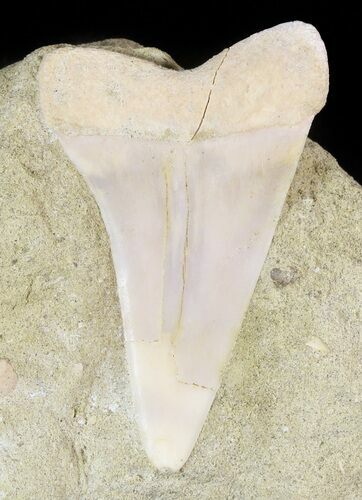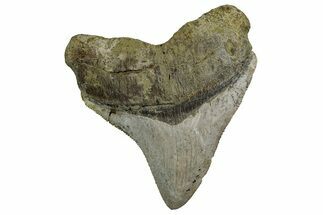This Specimen has been sold.
1.7" Mako Shark Tooth Fossil In Rock - Sharktooth Hill, CA
Here is a nicely preserved straight Mako tooth (Isurus hastalis) found at Sharktooth Hill near Bakersfield, CA. These teeth have beautiful coloration which is quite distinct to the location. Quite impressive for a tooth that is 15.5 million years old. It's still partially embedded in the sandstone in which it was found.
This shark, whose teeth can be found in deposits worldwide, lived from the Eocene to the Pleistocene. It had been historically classified as a broad-toothed mako shark (Isurus hastalis). It was then reclassified as Cosmopolitodus hastalis, making it a type of extinct mackerel shark.
More recent research has reclassified it as part of the white shark lineage, which would rename the species to Carcharodon hastalis. You can read more about this here. What classification is correct is still under debate, leading to lots of different labels for these teeth. We prefer the most recent interpretation and label them as Carcharodon hastalis.
Teeth of this shark have been found up to 3 1/2 inches in length but teeth over 2 1/2 inches are uncommon and very rare over 3 inches.
More recent research has reclassified it as part of the white shark lineage, which would rename the species to Carcharodon hastalis. You can read more about this here. What classification is correct is still under debate, leading to lots of different labels for these teeth. We prefer the most recent interpretation and label them as Carcharodon hastalis.
Teeth of this shark have been found up to 3 1/2 inches in length but teeth over 2 1/2 inches are uncommon and very rare over 3 inches.
About Sharktooth Hill
Sharktooth Hill is located in the foothills of the Sierra Nevada Mountains near Bakersfield, California. It represents an exposure of the Temblor Formation, a middle-Miocene marine deposit. 15 million years ago the sea levels were substantially higher, and central California was covered by what is known as the Temblor Sea.
Two highly fossiliferous bone beds in the formation were created when fossils originally deposited at the bottom of the sea eroded out of the rocks, were concentrated by ocean currents, and subsequently reburied. Because the fossils in these bone beds are reworked, only isolated teeth and bones are found in these beds.
Today, the original Sharktooth Hill is a National Natural Landmark, but private property surrounding it contains operational pay-to-dig fossil quarries.
Sharktooth Hill is located in the foothills of the Sierra Nevada Mountains near Bakersfield, California. It represents an exposure of the Temblor Formation, a middle-Miocene marine deposit. 15 million years ago the sea levels were substantially higher, and central California was covered by what is known as the Temblor Sea.
Two highly fossiliferous bone beds in the formation were created when fossils originally deposited at the bottom of the sea eroded out of the rocks, were concentrated by ocean currents, and subsequently reburied. Because the fossils in these bone beds are reworked, only isolated teeth and bones are found in these beds.
Today, the original Sharktooth Hill is a National Natural Landmark, but private property surrounding it contains operational pay-to-dig fossil quarries.
SPECIES
Carcharodon (Isurus) hastalis
LOCATION
Sharktooth Hill, Bakersfield, CA
FORMATION
Temblor Formation
SIZE
1.7" long
CATEGORY
SUB CATEGORY
ITEM
#46487
We guarantee the authenticity of all of our specimens.
 Reviews
Reviews












